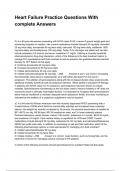Exam (elaborations)
Heart Failure Practice Questions With complete Answers
- Course
- Institution
PJ is a 63-year-old woman presenting with NYHA class III HF, a recent 5-pound weight gain and worsening dyspnea on exertion. Her current medications include lisinopril 20 mg daily, carvedilol 25 mg twice daily, furosemide 40 mg twice daily, celecoxib 100 mg twice daily, metformin 1000 mg twice dail...
[Show more]



